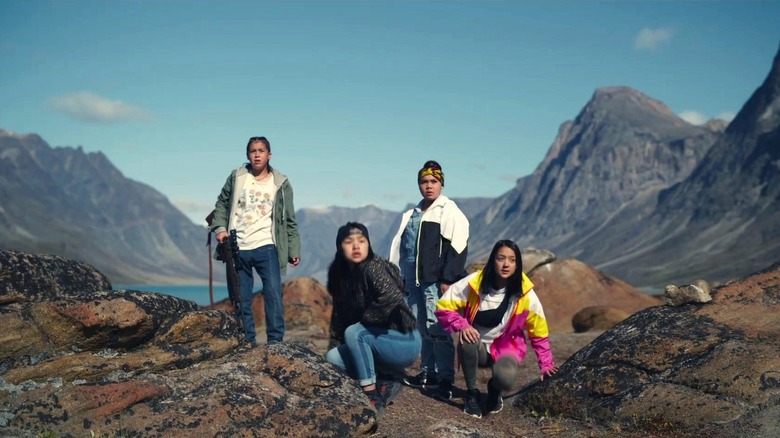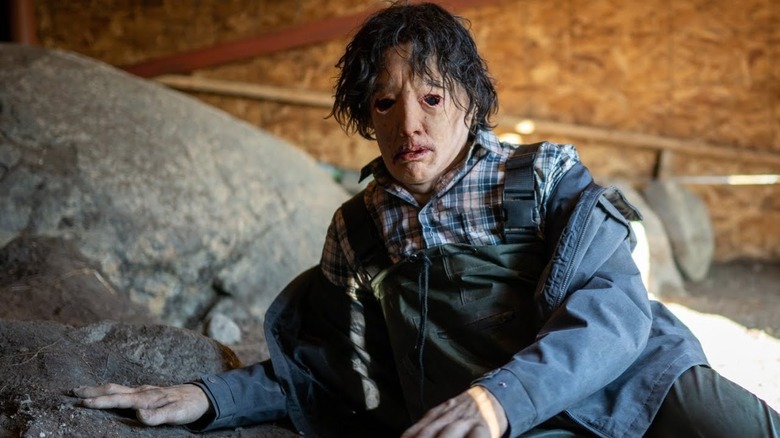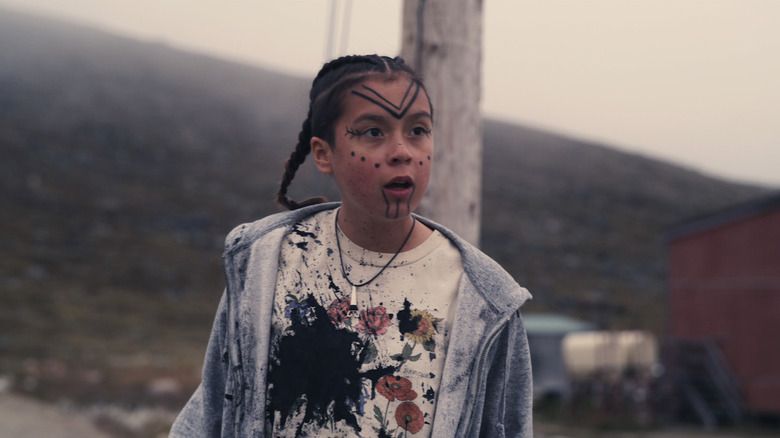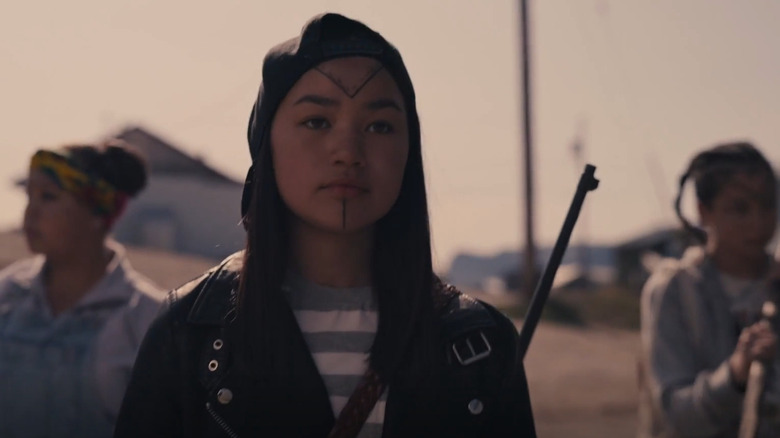Slash/Back Director Nyla Innuksuk Lived In A High School While Shooting Her Alien Invasion Movie [Exclusive Interview]
"Slash/Back" is an alien invasion movie delight. Nyla Innuksuk's film has a bit of "The Goonies" and "E.T." in its DNA. The story is set on Pangnirtung, which is on Baffin Island in Nunavut, Canada. It's the first film shot there, and it's also the first full-length film Innuksuk has directed. Previously, the CEO of Mixtape VR directed short films, documentaries, and wrote comics for Marvel.
Innuksuk shakes up just another day in the lives of teenagers in Pangnirtung with an alien invasion. Together, a group of friends must band together and fight, not to mention continue to text, talk about boys, and explore their relationship to their community and history. It's a familiar and new hangout movie with subtext, laughs, and practical alien effects. Recently, Innuksuk told us about her experience bringing those effects to life and living in a high school with her crew.
'He would be wearing the skin-suit versions of the actor's skins'
This is almost like a Richard Linkater movie invaded by aliens.
[Laughs] I love it.
Was that hangout feel, the sometimes mundane teenage life, important to you?
Yeah, it was one of the things that — well, working with teenagers, I really had such a blast. Certainly, in developing the project, we realized that even if this crazy thing was going on, this kind of apocalyptic thing, that they would still somehow find the time to be talking about boys and gossip and that sort of thing. So being able to play around with some of that stuff and the bored teenagers was really fun. Our cast is just such a fun group.
It's refreshing to watch creature effects all in daylight and not hidden by night. How did you want to strike the balance with practical and CG?
Yeah, it was pretty crazy only because — well, it was as if it was over the course of one day in this town where for 11 days the sun just sets in the sky, and then just circles around and never sets. And so, of course, this is a community where the weather was constantly changing every single day, and so to match throughout the summer was bonkers. I also had shot in the Arctic in the winter time when it's dark out, and I know I did not want to do that. I think Pang and the Arctic is so beautiful in the summer, and it's a way that people haven't really seen the Arctic before, I think. I thought that would be really special.
Within this community of Pang, in the summer, once the sun's out, the kids just kind of have a run of the town, because the parents still have to go to work, but they're done with school and just out at all hours of the day. It's just expected, because there's soon going to be 24-hour darkness. This time of the year when the kids start to take over the town, I think, was just a fun time to explore.
I love the idea of working with practical effects, and I really wanted to do as much practical as possible. We actually did the entire polar bear sequence practically. I had this big, huge polar bear suit made for our contortionist and it was made so that he could only wear it if he was backwards and upside down. And so, he was having to be fully arched, and he was running downhill like that for a full day. I thought it looked so cool, but so weird. I knew it was almost a little too campy or something, which I kind of liked, but we just ended up replacing that with the CGI bear and matching the movements.
Our contortionist, Troy [James], we worked together to figure out how would a creature move if it was made up of all these tentacles, and then how would it walk? And he's amazing. Double-jointed in every joint, and can do these crazy things. So whenever we had these aliens that take over animals and wear their skins as disguises, that when they were in human form, Troy, he would be wearing the skin-suit versions of the actor's skins, and performing all the body movements.
Ofilio [Portillo] did the stunt-heavy stuff. If you ever saw two creatures at once, then it would be the two of them. And Ofilio would kind of learn the movements from Troy, although Troy really was able to do things that other humans just can't do. And then getting to work with a different group of awesome, cool people to make the CG stuff, that was also just another kind of fun. Thinking about that more as enhancements, and then figuring out the tentacle-movements, and all on a budget.
For me, that's one of the big draws to making genre. Part of me feels it's got to be more fun than making other movies because you're getting to work with people on these really cool solutions. Like, "How do we make the practical version of the CG ship?" Because we made the CG ship first and then shot the opening scene later. And so, our practical effects person just made a practical version of the CG ship, but in much smaller form. They made it so that it could connect to a pump, so someone could be pumping it and making it beat. It was also connected to another thing so it could have smoke coming out.
Of course, that was all shot during the pandemic when we had to have such a limited crew. It meant we couldn't bring up our special effects team. We were having to have our producers and aides pumping [for the ship]. But those were the times where you're trying to figure out these crazy solutions and it was like, "Do you know what? This kind of reminds me of being back in high school with my friends, figuring out how to make the blood spray in this direction."
'All of our meals were served in the high school gym'
Even though it's a smaller budget, did you find the location alone was giving you and your cinematographer this great sense of scale?
It was so special. The community of Pang is just stunning. I filmed a documentary there before, and my nephews are from this community, so I knew that I wanted to try and make this movie in their hometown because I thought that would be fun for them. It's so beautiful, but logistically, how we were going to do it? There wasn't enough room, really, in town for a crew. And so, we went and we did some location scouting in the capital city of Iqaluit, which is still really small — 7,000 people.
We were like, "We can shoot most of it here and then maybe shoot a couple of exterior stuff in Pang." And then we went to Pang and I was there for two hours, and I went to one of my producers, I was like, "We've got to be here. We have to figure out a way to be here." We went over the next day to the principals of the high school and the grade school and asked if we could move in for the summer. And so, as soon as classes were out, we set up 60 beds and mattresses and turned all the classrooms into bedrooms for our crew. Guy Godfree, my cinematographer, shared a classroom with my assistant director, Ryan Hyland. Two of my favorite people on the planet.
They're all working so hard and then they're going back and rooming together in a classroom. All of our meals were served in the high school gym. There are no restaurants in town. It was a crazy challenge for all of us, but the people that we ended up getting, that signed up for this kind of adventure, were amazing. We just figured out how to make it work.
A lot of great people worked on this movie. [Composer] Michael Brooks' score is very cool.
Mark's amazing. Tanya Tagaq is an amazing musician as well. She gave us hundreds of hours of vocalizations that we could use for the creatures. Just such a blast. I think that, really, what's so special about movies is that it is a team sport. You get this opportunity to be working with amazingly talented people and creative people, coming together and making something together. I love sound design and music, and wish I could have spent so much more time in that space. But yeah, that was a real gift to have. Whenever I was sent music stems, it was a special treat.
'It was learning a million lessons a day'
You grew up making movies with friends and, like you said, had a blast figuring out how to get blood to splatter just right. Shooting a feature film, were there any more similarities to those early days of making movies with your friends?
Oh my gosh. I mean, it was a bit of a roundabout way for me to get back to directing this. At one point, I maybe thought when I was initially going to school I would be an editor. And then I fell in love with producing, and with this project I knew I wanted to be writing it. And so, I was thinking I was going to be writing and producing this movie. I had done a lot of interactive projects. I'm really into video games and VR and augmented reality and had done work with a great producer, Dan Beckerman, who produced "The Witch." Dan was on board when I was just a writer and producer.
It took me actually getting sick to make this choice like, "What am I doing? I want to be directing this." And thank goodness everyone else just went along with it. But it was this crazy process of learning how to make a movie by doing it. It was learning a million lessons a day. Basically, by the end I was feeling like, "Okay, how can we make sure this never happens again? How can I make sure that I'm taking all of these lessons and getting better?"
There would be times where I'm overwhelmed, but then at the same time being like, "Oh yeah. All of these things I've been doing ever since I was a kid all led up to this thing." All those times I spent making movies with my friends. We would make these really silly movies. One of the movies was called "B**** of the House." It was about my friend's dog, who was this really sweet dog, but in the plot of the movie, he snaps and goes on a murderous rampage and kills everybody in his family, this little dog. And so, we had to shoot everybody in my friend's family just doing their things and coming to this incredibly gruesome death at the hands of this sweet dog. Every death was more violent than the next.
It was so silly, but these are the kinds of things that are, like, "This is what you're now doing when you've got support." One of the things in the script was, Uki (Nalajoss Elssworth) plays with a piece of plastic. And then I've got people coming up to me with five pieces of plastic being like, "What one do you want?" It was just like, "Wow, this is a different situation from when it was me and three people doing every role, and just figuring out how to solve these problems." In some ways it was so different, but then in other ways, not that different.
What I mentioned about getting to work with all these amazing people, you get to find people that have these skills and have this experience that you don't have. And hopefully, having a clear enough idea of what you want, but then also being open enough to other people's ideas, which of course, I sometimes struggle with. I like to have ideas, and sometimes can be a bit stubborn about it, but I think you do have to really be open. Sometimes you plan for a certain thing, and then these wonderful things can happen and change, and great things can come out of those moments, too.
"Slash/Back" is now playing in limited release and available on VOD.



